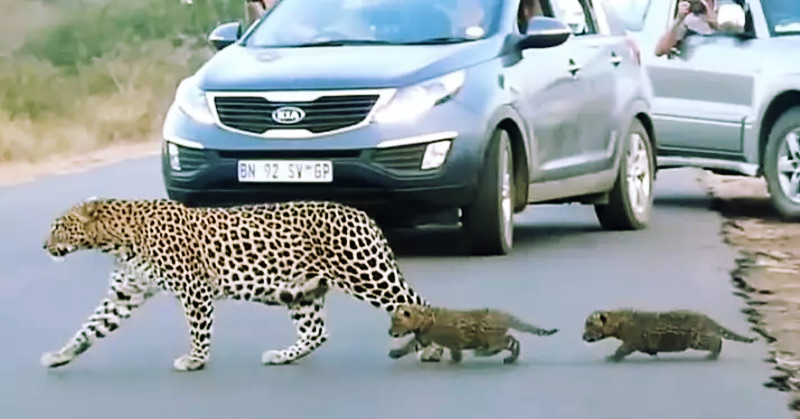The opportunity to witness wildlife in action is rare, but always exciting. Even rarer is the chance to see a wild animal with her babies. Visitors to Kruger National Park in South Africa, before the park closed due to the coronavirus, had the opportunity to see just that.
Mother Leopard Stops Traffic
As tourists looked on from their cars, a mother leopard taught her two tiny cubs a very important life lesson: how to cross a busy road. The scene was caught on camera by Thinus Delport, who had brought his two daughters to the park.
“Early morning, my daughters and I left the camp looking for leopards. They were convinced that there are no leopards in the Kruger, as neither of them had ever seen one,” said Delport. “As we drove, I jokingly convinced them to start singing in the car, to draw the leopards out, and so they did – and to my surprise – it actually worked.” [1]
Whether or not the singing is what caused the big cat to emerge, of course, is impossible to know, but regardless, the girls got to witness an extraordinarily rare sight.
Delport, who has been visiting Kruger for more than fifty years, has never even seen a leopard in the park, let alone a leopard with its babies.
“This was an extremely rare sighting, and you don’t often get to see a leopard mother relocate her cubs when they are still so young,” he said. “This just came to show that patience really does pay off,” [2].
The video shows the mother leopard first emerging from the bushes, then walking into the middle of the street to make sure it was safe. She then returned to the side of the road to retrieve her cubs. One of her babies had a little more trouble, and cried out to its mother for assistance. You can watch the entire video below.
Read: Dolphins appear to glow as they glide through bioluminescent waves
Anti-Social Animals
Leopard sightings are rare because the big cats prefer to remain hidden, lurking in dense bush, and usually only emerge in the late afternoon or at night to hunt. It is the second-biggest African cat next to the lion, however unlike the lion, it does not roar, or typically make any sound at all [3].
Leopards are highly adaptable cats, and so can be found in a variety of habitats, ranging from deserts to rainforests. They are widely distributed in sub-Saharan Africa, however, their populations in western and northern Africa, as well as the Middle East, Russia, and Asia have been reduced.
This ability to adapt to a wide range of environments has allowed leopards to fare better than many other big cats, however, they have been eliminated from approximately 37 percent of their African range.
The biggest threat to leopards is the loss of habitat and prey, as well as being killed by farmers who are trying to protect their livestock. They are heavily hunted in southern Asia for their skin and bones, and in central Africa, they are hunted for their skin, teeth, and claws. They could also be driven to extinction in tropical forests because of competition from bushmeat hunters [4].
Respect Wildlife
Witnessing majestic creatures like leopards in their natural habitats is a once-in-a-lifetime opportunity, and it is important to always remember that wildlife should be viewed respectfully, and from a distance.
Wildlife is best learned through quiet observation. You should not disturb them in an effort to get a closer look, as you could scare them and force them to flee. You should never feed, touch, or attempt to pick up wild animals, because it is stressful for them, and they could be carrying rabies or other diseases [5].
We are lucky to be able to share our planet with such a wide variety of incredible creatures, and it is our responsibility to act in such a way that does not negatively affect them, or reduce their chances of survival.
Keep Reading: With No Tourists, Australian Scuba Tours Are Planting Coral Instead
- https://www.ladbible.com/news/animals-leopard-mother-crossing-road-with-her-two-cubs-caught-on-camera-20200423
- https://www.huffingtonpost.ca/entry/leopard-cubs-cross-road_n_5ea658ffc5b6dd3f9086e10a?ri18n=true
- https://www.krugerpark.co.za/Kruger_National_Park_Wildlife-travel/kruger-park-wildlife-leopards.html
- https://wildcatconservation.org/wild-cats/africa/leopard/
- https://lnt.org/why/7-principles/respect-wildlife/

